Myelodysplastic syndromes
Myelodysplastic syndromes (MDS) are a group of hematologic malignanciesof the pluripotent hematopoietic stem cells. These disorders arecharacterized by ineffective hematopoiesis, including abnormalities inproliferation, differentiation, and apoptosis.
Myelodysplastic syndromes (MDS) are a group of hematologic malignancies of the pluripotent hematopoietic stem cells. These disorders are characterized by ineffective hematopoiesis, including abnormalities in proliferation, differentiation, and apoptosis. The overall clinical result is peripheral cytopenias in the setting of a normocellular or hypercellular bone marrow and a high incidence of transformation to acute leukemia.
The incidence of MDS approximates 2 cases per 100,000 population per year, with 30 cases per 100,000 population per year in patients > 70 years old. It is estimated that approximately 15,000 to 20,000 new cases are diagnosed annually in the United States. Unfortunately, there are no accurate statistics on the actual incidence of MDS.
Epidemiology
Gender The overall incidence of MDS is slightly higher in males than in females (1.5–2.0:1).
Age The incidence of MDS increases with age, with a median age at diagnosis of about 70 years. MDS is rare in children; childhood cases are more frequently associated with monosomy of chromosome 7.
Etiology and risk factors
MDS is a clonal disorder of bone marrow stem cells. The vast majority of cases (80%–90%) occur de novo, whereas 10%–20% of cases are secondary. The etiology of de novo MDS is unclear. Exposure to radiation and/or cytotoxic agents is a recognized etiologic factor in secondary disease forms. Cumulative exposure to environmental toxins, genetic differences in leukemogen susceptibility and metabolism, and genomic senescence may contribute to disease pathogenesis in de novo cases.
Genetic factors It has been suggested that a genetic change causes an irreversible alteration in the structure and function of the stem cell, with disruption of a multistep process involving control of cell proliferation, maturation, and interactions with growth factors; mutations of tumor-suppressor genes and proto-oncogenes; and deregulation of apoptosis.
Constitutional childhood disorders, such as Fanconi’s anemia, Shwachman-Diamond syndrome, Down’s syndrome, neurofibromatosis, and mitochondrial cytopathies, have been associated with MDS and monosomy of chromosome 7.
Environmental factors Exposure to benzene and its derivatives may result in karyotypic abnormalities often seen in MDS and acute myelogenous leukemia (AML). Persons chronically exposed to insecticides and pesticides may have a higher incidence of MDS than the general population.
An increased incidence of MDS has been reported among smokers and ex-smokers, possibly linked to associated exposures to polycyclic hydrocarbons and radioactive polodium present in tobacco smoke.
An association of MDS with magnetic fields, alcohol, or occupational exposure to other chemicals has not been demonstrated.
Antineoplastic drugs Therapy-related myelodysplasia and therapy-related AML are recognized long-term complications of chemotherapy and radiotherapy. Therapy-related MDS usually develops 3–7 years after exposure to chemotherapy and is most frequently related to complete or partial loss of chromosomes 5 or 7 in patients previously treated with alkylating agents. Approximately 80% of cases of AML occurring after exposure to antineoplastic drugs, particularly alkylating agents, are preceded by MDS.
More than 85% of patients who develop chemotherapy-related leukemia or MDS have been exposed to alkylating agents. Patients exposed to nitrosoureas have a relative risk of developing MDS or AML of 14.4 and a 6-year actuarial risk of 4%. The mean cumulative risk of leukemia in patients exposed to epipodophyllotoxins (eg, etoposide and teniposide [Vumon]) is about 5% at 5 years. Most of these therapy-related leukemias are not preceded by a dysplastic phase and are associated with abnormalities in chromosome 11q23.

Autologous bone marrow transplantation (BMT) has also been associated with a 5-year actuarial risk of MDS of 15% (95% confidence interval, 3.4–16.6). Fluorescent in situ hybridization (FISH) analyses of pretreatment bone marrow specimens for informative cytogenetic markers indicate that these secondary myeloid malignancies derive from clones demonstrable before the transplant procedure. Prior therapy with fludarabine, older age, low CD34+ dose, and prolonged platelet reconstitution have been associated with the development of MDS or AML in patients with lymphoid malignancies after autologous stem-cell transplantation (SCT).
Classification
In 1982, the French-American-British (FAB) group proposed a classification system for MDS that consists of five subgroups, based on the percentage of blast cells in the peripheral blood and bone marrow, the presence of ringed sideroblasts in the bone marrow, and the monocyte count in the peripheral blood (Table 1). The five subgroups are:
- refractory anemia (RA)
- refractory anemia with ringed sideroblasts (RARS)
- refractory anemia with excess blasts (RAEB)
- refractory anemia with excess blasts in transformation (RAEB-t)
- chronic myelomonocytic leukemia (CMML).
The presence of Auer rods in granulocyte precursors classifies a patient as having RAEB-t, even if blasts comprise < 20% of bone marrow cells. The presence of > 30% blast cells in the bone marrow or peripheral blood establishes the diagnosis of AML rather than MDS.
More recently, the World Health Organization (WHO) has proposed a modified classification of hematologic malignancies (Table 2). The following changes have been proposed, based on the effect of cytogenetics and the number of dysplastic lineages on clinical behavior:
- The FAB classification of RAEB-t is eliminated.
- The blast percentage that defines AML is changed to ≥ 20%.
- RA and RARS are defined by dysplasia restricted to the erythroid lineage either with or without ringed sideroblasts, respectively.
- The presence of dysplasia in erythroid and nonerythroid lineages (multilineage dysplasia with or without ringed sideroblasts) and 5q- syndrome are regarded as separate entities of MDS.
- RAEB is divided into two categories distinguished by marrow blast percentage (ie, RAEB-1: 5%–9%; RAEB-2: 10%–19%) or the presence of Auer rods (RAEB-2).
- A category is added to include unclassifiable MDS defined by nonerythroid, single-lineage dysplasia.
- CMML is included in a separate category of myelodysplastic/myeloproliferative diseases that also includes atypical chronic myelogenous leukemia and juvenile myelomonocytic leukemia. CMML is further classified into CMML-1 (≤ 9% blasts), CMML-2 (10%–19% blasts), and CMML-Eos (eosinophils ≥ 1,500/µL).
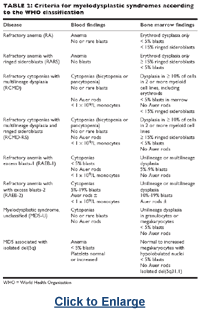
This proposal represents a step ahead, but there are some aspects that still need to be addressed. For example, some biologic features that have been associated with MDS, such as the presence of spontaneous apoptosis, increased angiogenesis, and infrequent FLT3 mutations, may define better specific subsets, and the WHO classification does not incorporate unfavorable cytogenetic patterns.
Signs and symptoms
Nearly 50% of patients with MDS are asymptomatic at the time of initial diagnosis. Signs and symptoms relate to hematopoietic failure, leading to anemia, thrombocytopenia, or leukopenia.
Symptoms related to anemia may range from fatigue to exertional dyspnea that may exacerbate angina or cause congestive heart failure.
Infection Approximately one-third of patients report recurrent localized or systemic infections as a result of granulocytopenia or dysfunctional granulocytes and monocytes.
Bleeding manifestations, such as petechiae or gross hemorrhage, can occur with thrombocytopenia or platelet dysfunction. However, < 10% of patients present with serious bleeding.
Organomegaly and lymphadenopathy Splenomegaly and/or hepatomegaly may be found in 5%–25% of patients. A large spleen is more frequently seen in CMML.
Acute neutrophilic dermatosis (Sweet’s syndrome) and pyoderma gangrenosum may be observed, particularly in patients with CMML or advanced MDS.
Paraneoplastic syndromes Diabetes insipidus, vasculitis, and other rare paraneoplastic syndromes have been described in patients with MDS.
Laboratory features
Peripheral blood
Anemia is the most frequent abnormality in MDS, with > 80% of patients presenting with hemoglobin concentrations < 10 g/dL. The anemia is usually normocytic or macrocytic, but the mean corpuscular volume rarely exceeds 120 µm3.
Other RBC abnormalities Hypochromic changes and red-shape abnormalities are frequent, including poikilocytosis, anisocytosis, elliptocytosis, macro-ovalocytosis, and sometimes stomatocytes. Stippled and nucleated RBCs can be observed in 10% of cases. Reticulocyte counts are usually reduced.
WBC abnormalities The peripheral WBC count may be normal or low in MDS but is frequently elevated in CMML. The proportion of monocytes may be increased, and a circulating monocyte count of ≥ 1 × 109/L defines CMML.
Neutropenia is seen in about 50% of patients with MDS at diagnosis, often associated with pseudo–Pelger-Hut anomaly (neutrophils have a condensed chromatin and unilobed or bilobed nuclei with a pince-nez shape), ring-shaped nuclei, hypogranulation, and hypolobulation or other signs of dysgranulopoiesis.
Granulocytes frequently disclose reduced myeloperoxidase activity, increased α-naphthyl acetate esterase activity, and other functional abnormalities.
Chemotactic and bactericidal capability is impaired, which can potentiate the risk of infection, even in the presence of normal WBC counts.
Patients frequently have a decreased number of natural killer cells and helper T lymphocytes.
Platelet abnormalities Thrombocytopenia is present at diagnosis in approximately 30% of patients.
Platelets may be abnormally large; have poor granulation; or have large, fused central granules.
Decreased platelet aggregation is observed when platelets of patients with MDS are challenged with collagen or epinephrine.
Thrombocytosis may be seen in association with the 5q- syndrome.
Bone marrow
Bone marrow aspiration and biopsy should be performed in every patient suspected of having MDS or unexplained persistent cytopenias. The bone marrow is normocellular or hypercellular in 85%–90% of patients with MDS but may be hypocellular for the patients’ age in as many as 10%–15%.
Trilineage dyspoiesis The main morphologic feature of MDS is hematopoietic dyspoiesis, although myelodysplastic features do not always involve all three lineages. Cytologic dysplasia must be detected in ≥ 10% of the affected lineages.
Dyserythropoiesis Erythroblasts usually have a megaloblastoid appearance. Iron may be abnormally deposited in mitochondria and is easily stained with Prussian blue, producing a ring-shaped staining pattern around the nucleus. Pathologic sideroblasts have five or more granules/cell.
Dysgranulopoiesis The characteristic findings in dysgranulopoiesis are hypogranulation and hyposegmentation with nuclear morphologic abnormalities.
Excess bone marrow blasts Bone marrow blasts > 5% but < 30% are seen in 30%-50% of patients with MDS; in the context of myelodysplasia, this finding is a feature of MDS.
The FAB group distinguishes three types of blasts on the basis of the maturation as assessed by morphology. Type I blasts have an uncondensed nuclear chromatin, one to three nucleoli, and basophilic cytoplasm without a Golgi zone. Cytoplasmic granules and Auer rods are absent. In type II blasts, the nuclear/cytoplasm ratio is lower than in type I blasts, and few primary granules are seen. Type III blasts have 20 or more azurophilic granules without a Golgi zone.
Dysmegakaryocytopoiesis At least 10 megakaryocytes should be evaluated. Micromegakaryocytes are small cells with a diameter two times smaller than the normal megakaryocyte (< 80 µm). Multiple, dispersed, small nuclei or mononucleated forms, as well as hypogranulated megakaryocytes, also can be found.
Other abnormalities An increase in reticulin and collagen fibers in the bone marrow may be seen in some patients.
Angiogenesis Increased marrow vascularity and increased levels of angiogenic cytokines such as vascular endothelial growth factor (VEGF), and basic fibroblast growth factor (bFGF) have been described in patients with MDS.
Other laboratory findings
Serum iron, transferrin, and ferritin levels may be elevated. As a result of ineffective hematopoiesis, lactic dehydrogenase (LDH) and uric acid concentrations are frequently increased. Monoclonal gammopathy, polyclonal hypergammaglobulinemia, and hypogammaglobulinemia are found occasionally but may be detected in up to 15% of patients with CMML.
Cytogenetic and molecular findings
Chromosomal abnormalities
Clonal cytogenetic abnormalities are found at diagnosis in 50%–60% of patients with de novo MDS and 75%–85% of those with secondary MDS or AML. An interesting feature that distinguishes MDS from AML is the high incidence of complete or partial chromosomal loss or, less frequently, chromosomal gain and the relative rarity of translocations. Among the translocations, unbalanced translocations leading to a loss of chromosomal material are most frequent.
Common cytogenetic abnormalities are listed in Table 1. None of them is specific for MDS, since all can be found in other myeloid disorders.
Some of the most frequent abnormalities are interstitial deletion of the long arm of chromosome 5 (5q-), monosomy of chromosome 7, trisomy of chromosome 8, 20q-, and loss of the Y chromosome. “Complex” cytogenetic abnormalities involving three or more chromosomes occur in approximately 15% of de novo MDS cases and 50% of secondary MDS cases.
Therapy-related MDS Loss of chromosome 7 and/or 7q- has been reported in as many as 50% of patients previously exposed to chemotherapy for other malignancies, most frequently in association with prolonged use of alkylating agents. Other abnormalities commonly associated with prior exposure to alkylating agents include -5 and/or del(5q) in 25% of cases and involvement of chromosomes 17p and 21 in 10%–15%. Complex chromosomal abnormalities may be found in nearly 50% of patients.
Cytogenetics and FAB classification
RA and RARS Approximately 15%–30% of patients with RA and RARS have abnormal karyotypes. The most frequent abnormality in patients with RA is 5q, whereas the most common abnormalities in patients with RARS are 5q-, +8, and 20q- (each occurring in 20% of patients).
RAEB and RAEB-t Nearly 60% of patients with RAEB and RAEB-t have cytogenetic abnormalities, with 5q-, -7, 7q-, and +8 being the most frequent.
CMML Chromosomal abnormalities are found in 25%–30% of patients with CMML; the predominant abnormalities include -7, 7q-, +8, 12q-, and t(5;12). Interestingly, 5q- is seen in < 1% of cases of CMML.
Monosomy of chromosome 7 is found in up to 25% of children with MDS, most frequently as an isolated abnormality. In contrast, older patients most often have monosomy of chromosome 7 associated with other chromosomal abnormalities.
5q- syndrome
The isolated interstitial deletion characteristic of the 5q- syndrome involves a variable segment length that includes the critical deleted region at 5q31, a region known to contain genes coding for granulocyte-macrophage colony-stimulating factor (GM-CSF), macrophage colony-stimulating factor (M-CSF), interleukin (IL)-3, IL-4, IL-5, IL-9, IL-12, M-CSF receptor, platelet-derived growth factor receptor-beta, interferon-regulatory factor-1 (IRF-1), endothelial cell growth factor, glucocorticoid receptor, and early growth response gene-1 (EGR-1). However, the critical gene deletion involved in this syndrome has yet to be identified.
Clinical features This syndrome has characteristic clinical features, including older age, female predominance, diagnosis of RA without excess (< 5%) blasts in 75% of cases, macrocytosis with severe anemia, erythroblastopenia, normal leukocyte counts, normal or increased platelet counts, and hypolobulated megakaryocytes in the bone marrow.
Progression to AML is infrequent (< 20%), and the prognosis is usually good. However, not every patient with del(5q) has this syndrome and its associated good prognosis. Additional cytogenetic abnormalities or the presence of ≥ 5% blasts in the peripheral blood or bone marrow are inconsistent with this diagnosis.
Molecular findings
The ras family of genes is most frequently altered in MDS, although other abnormalities involving NF1, FMS, p53, TEL, EVI, AXL, TEC, HCK, c-mpl, and other genes have also been described.
Mutations in ras Mutations in the ras family occur in approximately 20%–40% of patients with MDS but are most frequently found in those with CMML. Mutations in ras are more common in codons 12, 13, and 61. Mutations in N-ras are more common than those in K-ras or H-ras.
A difference in the surface expression of phosphatidylserine (a marker of apoptosis) on cell membranes among de novo AML, MDS, and secondary AML and normal bone marrow cells has been found (increased in MDS and secondary AML). Epigenetic silencing of the p15 tumor-suppressor gene by promoter hypermethylation occurs particularly among patients with high-risk MDS and is associated with a poor prognosis. FLT3 mutations or internal tandem duplications occur much less frequently in MDS (usually < 5%) than in AML.
Staging and prognosis
Prognostic factors
FAB and WHO classifications The FAB classification has a long history of use to evaluate survival and risk for AML transformation (Table 1). The WHO classification has similar prognostic implications, based primarily upon the prognostic impact of blast percentage and the number of dysplastic lineages.
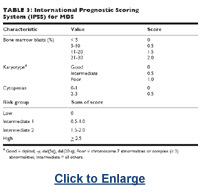
Cytogenetics Patients with complex karyotypes and abnormalities in chromosome 7 have a poor prognosis, whereas those with a normal karyotype, -Y, 5q-, or 20q- have a favorable prognosis.
Peripheral cytopenias (hemoglobin level < 10 g/dL, absolute neutrophil count [ANC] < 1.5 × 109/L, and platelet count < 100 × 109/L) have a cumulative adverse effect on prognosis.
Other prognostic factors Other parameters associated with a poor outcome include CD34 cell expression, high serum LDH levels, expression of the c-mpl gene, ras mutations, p-glycoprotein (Pgp) expression, p15 inactivation, and p53 mutations. However, it is unclear whether these factors have independent prognostic value.
International Prognostic Scoring System (IPSS)
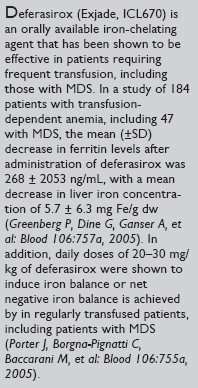
An International MDS Risk Analysis Workshop has proposed a system that combines clinical, morphologic, and cytogenetic data to generate a consensus prognostic system.
By multivariate analysis, the most significant independent variables were percentage of bone marrow blasts, cytogenetics, and number of cytopenias (Table 3). It is important to keep in mind, however, that other variables (eg, age and prior therapy) not included in this system may alter the prognosis and influence the results of therapy among patients in similar IPSS groups. Still, this may be the most valuable risk classification for treatment planning.
Treatment
The treatment of MDS is dictated by the risks imposed by the disease, age, and patient preference. Suggested guidelines are outlined in Table 4 and discussed below.
Supportive care
The use of transfusions affords temporary benefits and is an alternative that can be considered in patients with lower risk MDS or that otherwise can be used in conjunction with more definitive therapy. To delay or prevent end-organ complications, chelation therapy should be considered when red blood cell transfusions exceed 25 U or ferritin levels > 1,800 ng/mL.
Cytokines
Recombinant human erythropoietin (rHuEPO [Epogen, Procrit]) may decrease transfusion requirements in 15%–25% of patients with MDS, usually those with low plasma levels of EPO (< 100 mU/mL). The addition of granulocyte colony-stimulating factor (G-CSF, filgrastim [Neupogen]) or GM-CSF to rHuEPO may increase the response rate, mostly in patients with low transfusion requirements.
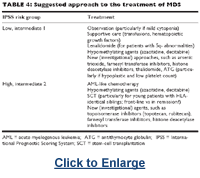
Darbepoetin alfa (Aranesp) is a hypersialated form of EPO with an extended half-life. Trials of darbepoetin alfa in MDS have shown comparable activity to recombinant EPO with or without G-CSF with less frequent dosing. Preliminary results of a phase II study investigating the benefit of weekly darbepoetin alfa (at a dose of 300 µg) in 55 lower risk patients with low endogenous EPO levels (< 500 mU/mL) reported a major erythroid response rate of 49%, with few failures salvaged by the addition of G-CSF. These data suggest that response to darbepoetin alfa may be comparable to that expected with the combination of EPO and G-CSF. IL-11 (at low doses of 10 µg/kg/d) has been used in patients with bone marrow failure disorders, including MDS.
G-CSF and GM-CSF may improve neutropenia and decrease infections in up to 70% of patients with MDS, but the effect is usually transient. No increase in the probability of developing AML has been demonstrated with extended use of these cytokines.
Other alternatives
Antithymocyte globulin (ATG [Atgam]) has been associated with response (defined as independence from transfusions) in 34% of patients, which was sustained for a median of 36 months in 81% of them. Also, 48% had sustained platelet improvement and 55% had an increase in neutrophils. Younger patients and those with low platelet counts are more likely to respond than older patients and those with higher platelet counts.
A simple method for predicting response to immunosuppressive therapy in MDS has been proposed. It is based on the age of the patient, the duration of red blood cell transfusion dependence, and the HLA-DR15 status. Younger patients with a shorter duration of transfusion requirements have a higher predicted probability of response (40%–100%), particularly when their status is positive for HLA-DR15.
Cyclosporine significantly increases cell colony growth in laboratory studies of hypoplastic RA. Responses have been reported in a limited number of patients.
Lenalidomide Lenalidomide (Revlimid) is a thalidomide analog that belongs to the immunomodulatory family of drugs. Lenalidomide has numerous properties that make it attractive for the management of neoplastic and inflammatory conditions, including the inhibition of production of cytokines such as tumor necrosis factor-α (TNF-α) and interleukins-1 (IL-1)IL-6, IL-10, and IL-12. Lenalidomide is markedly more potent than thalidomide in inhibiting the secretion of TNF-α. In addition, lenalidomide may potentiate erythropoietin-induced signaling in erythroid progenitors and stimulate stem-cell differentiation to erythroid cells.
Lenalidomide has been recently approved for the treatment of patients with MDS with abnormalities in the long arm of chromosome 5 (5q- abnormalities), whether they are isolated or present together with other cytogenetic abnormalities. In a study of patients with transfusion-dependent MDS with 5q- abnormalities, 75% of patients responded, with 66% of the total population becoming transfusion independent. The response rate was similar regardless of whether the cytogenetic abnormality was isolated or seen in conjunction with other cytogenetic abnormalities, and more than half of the responses were durable for more than 1 year. In addition, a cytogenetic response was observed in 70% of patients. Lenalidomide has also been investigated for patients with MDS without 5q- abnormalities. Erythroid responses were seen in over 40%, with 27% of the total population becoming transfusion independent.
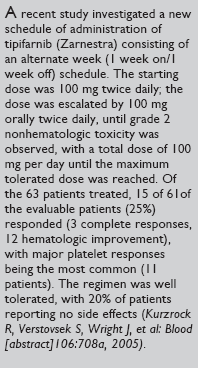
Azacitidine (Vidaza) and 5-Aza-2-deoxycytidine (DAC, decitabine) are hypomethylating agents that have shown activity in MDS. In a randomized trial, 191 patients with MDS (63% RAEB or RAEB-t) were treated with azacitidine or supportive care. Responses were observed in 60% of those treated with azacitidine (complete response [CR]: 6%; partial response [PR]: 10%; improvement: 47%) compared with 5% with supportive care. There was a significant improvement in probability of transformation to AML and overall survival when the confounding effect of early crossover to azacitidine was eliminated.
Azacitidine has recently been approved by the US Food and Drug Administration for the treatment of patients with all types of MDS. The standard dose is 75 mg/m2/d subcutaneously for 7 days every 4 weeks for as long as the patient benefits. Responses occur after a median of 3 to 4 cycles, so it is recommended to continue therapy for at least 4 cycles unless there is significant toxicity or progression of disease. The dose may be increased to 100 mg/m2/d after 2 cycles if no improvement has occurred. Myelosuppression may occur but is not a reason to discontinue therapy. Rather, patients should be supported during myelosuppression and should continue therapy to give patients the best opportunity of response.
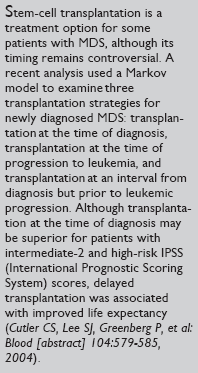
In a multicenter phase II study, 66 patients (73% RAEB or RAEB-t) were treated with decitabine. The overall response rate was 49% (CR: 20%; PR: 4%; improvement: 24%). The actuarial median response duration was 31 weeks, and median survival was 22 months. In addition, 31% of patients with cytogenetic abnormalities presented before treatment achieved a cytogenetic response. Cytogenetic response conferred a survival advantage to these patients.
Steroids, androgens, and pyridoxine are rarely effective, although they are often used clinically.
Chemotherapy
The rationale for this strategy stems from the concepts that MDS is a clonal disorder and that MDS and AML are overlapping illnesses with an arbitrary frontier defined by the WHO and FAB classifications (ie, a 20%–30% blast threshold).
The Cancer and Leukemia Group B (CALGB) treated 874 patients with AML and 33 patients with MDS with AML-like chemotherapy. The CR rate was 79% for patients with MDS vs 68% for patients with AML (P = .37), median CR duration was 11 vs 15 months (P = .28), and median survival was 13 vs 16 months. The authors concluded that the FAB distinction between MDS (RAEB and RAEB-t) and AML has minimal therapeutic implications.
Estey et al treated 372 patients with AML, 52 with RAEB, and 106 with RAEB-t with AML-type chemotherapy. CR rates were 62% for patients with RAEB, 66% for those with RAEB-t, and 66% for those with AML (P = .79). Event-free survival was significantly better for patients with AML/RAEB-t than for patients with RAEB. However, when cytogenetics and other prognostic variables were considered in a multivariate analysis, no difference in outcome could be identified among FAB subgroups.
These findings suggest that the prognosis is determined more by cytogenetics and other prognostic features than by the percentage of blasts or FAB classification. However, this finding does not necessarily mean that MDS and AML are biologically equivalent entities.
Combination regimens Different combination chemotherapy regimens have been investigated. The combination of cytarabine (Ara-C) and anthracycline is the cornerstone of intensive chemotherapy, leading to CRs in 40%–60% of patients. However, despite the fact that cytogenetic remissions frequently accompany hematologic CRs, the median remission duration and survival times are brief, rarely exceeding 1 year. The death rate during induction therapy is 5%–20%.
Myeloblasts in RAEB-t and secondary AML commonly express the multidrug exporter Pgp, which extrudes anthracyclines and limits their activity. A randomized, controlled trial performed by the Southwest Oncology Group (SWOG) reported a twofold improvement in survival for patients treated with an anthracycline- and Ara-C–containing induction and consolidation regimens with the Pgp antagonist cyclosporine added.
It is possible that certain chemotherapeutic agents may be particularly useful in MDS.
Topotecan (Hycamtin), a topoisomerase I inhibitor, has shown significant activity as a single agent in the treatment of MDS, with a CR rate of 37% in previously treated patients with RAEB/RAEB-t and 27% in patients with CMML. The median CR duration was 7.5 months, and survival was 10.5 months. Topotecan is well tolerated, with a mortality rate during induction therapy of < 5%.
Combinations of topotecan with Ara-C resulted in a 56% CR rate (66% in previously untreated patients). Similar CR rates were observed despite the risk category. This regimen is well tolerated, with an induction mortality rate of 7%. A randomized trial of topotecan and Ara-C vs idarubicin (Idamycin) and Ara-C showed that the topotecan combination was an equivalent regimen, possibly with lower toxicity.
SCT
Allogeneic SCT can be of benefit in a subset of patients with MDS. However, most series have concentrated on younger patients, who constitute a minority of patients with MDS and frequently have favorable cytogenetics and therefore a better prognosis. The best results to date have been reported in patients with a better prognosis (ie, those with RA/RARS). In most series, allogeneic SCT is associated with a long-term remission rate of approximately 40%, a 30% relapse rate, and a 30% rate of transplant-related death.
The timing of transplantation remains controversial. Runde et al reported on a group of 131 patients (median age, 33 years; range, 2–55 years) who underwent allogeneic SCT as front-line therapy without prior induction chemotherapy. The 5-year disease-free survival rate was 34%, overall survival rate was 41%, and transplant-related mortality was 38%. The actuarial probability of relapse at 5 years was 39%, with better results observed in the RA/RARS subgroup.
Patients with adverse cytogenetics have a poor outcome with other treatment modalities, and SCT can be considered for such patients during first CR. However, the long-term outcome for these patients after SCT has not proved to be superior to that after any other approach, although the procedure may prove to be curative in a small percentage of patients. SCT should be considered particularly in the setting of a clinical trial.
New applications for allogeneic SCT (eg, nonmyeloablative) to make this option available to the typical patient with MDS (who is frequently older and has other associated medical problems), as well as matched-unrelated donor SCT, should be investigated further.
Autologous SCT In the majority of patients with MDS, lymphocytes do not appear to be part of the clone, suggesting the presence of normal nonclonal stem cells. De Witte et al described 79 patients with MDS or secondary AML who underwent autologous SCT during first CR. The 2-year survival, disease-free survival, and relapse rates were 39%, 34%, and 64%, respectively. The
2-year survival rate for the MDS group was 40%, and treatment-related mortality was 9%. The best outcome was seen among patients with RA/RARS.
Treatment recommendations
Treatment of patients with MDS is an evolving and controversial issue, and enrollment in a clinical trial should be encouraged. Treatment can be considered according to the IPSS.
Patients with low or intermediate-1 IPSS scores can frequently be treated with supportive measures. Hematopoietic-promoting agents such as EPO, amifostine (Ethyol), ATG, and thalidomide (Thalomid) could be used alone or in combination. Patients with 5q- benefit from lenalidomide, particularly in terms of erythroid response, and this should be considered the treatment of choice. Some patients with MDS without the 5q- abnormality may also benefit from lenalidomide, but the use in this setting is still investigated. Azacitidine is now available and should be considered for all patients. Although decitabine is another good option, it currently is only available through clinical trials.
Patients with high or intermediate-2 IPSS scores have significant risk of mortality from cytopenias or AML evolution. They should be considered for treatment options with the intention to cure, extend survival, or delay the progression of AML. The hypomethylating agents (azacitidine and decitabine) are good alternatives for patients who are not candidates for curative therapy. Investigational agents should be strongly considered.
SCT is an alternative for younger patients with higher risk MDS and an HLA-identical donor, particularly patients with adverse cytogenetic abnormalities. However, the best results to date have been reported in patients with a better prognosis (ie, younger patients and those with RA/RARS). Therefore, allogeneic transplantation and other transplant alternatives should be considered preferentially in a research setting (eg, mixed-unrelated donor and minitransplants).
SUGGESTED READING
Bernard JF, Giraudier S, Rosenthal E, et al: High response rate to darbepoetin alpha in low risk MDS: Results of phase II study. Blood 104:24a, 2004.
Cortes J: CMML: A biologically distinct myeloproliferative disease. Curr Hematol Rep 2:202–208, 2003.
Ho AY, Pagliuca A, Kenyon M, et al: Reduced-intensity allogeneic hematopoietic stem cell transplantation for myelodysplastic syndrome and acute myeloid leukemia with multilineage dysplasia using fludarabine, busulphan, and alemtuzumab (FBC) conditioning. Blood 104:1616–1623, 2004.
Howe RB, Porwit-MacDonald A, Wanat R, et al: The WHO classification of MDS does make a difference. Blood 103:3265–3270, 2004.
Jadersten M, Montgomery SM, Dybedal I, et al: Long-term outcome of treatment of anemia in MDS with erythropoietin and G-CSF. Blood 106:803–811, 2005.
Kuendgen A, Strupp C, Aivado M, et al: Treatment of myelodysplastic syndromes with valproic acid alone or in combination with all-trans-retinoic acid. Blood 104:1266–1269, 2004.
Kurzrock R, Kantarjian HM, Cortes JE, et al: Farnesyltransferase inhibitor R115777 in myelodysplastic syndrome: Clinical and biologic activities in the phase I setting. Blood 102:4527–4534, 2003.
List A, Kurtin S, Roe DJ, et al: Efficacy of lenalidomide in myelodysplastic syndromes. N Engl J Med 352:549–557, 2005.
Malcovati L, Porta MG, Pascutto C, et al: Prognostic factors and life expectancy in myelodysplastic syndromes classified according to WHO criteria: A basis for clinical decision making. J Clin Oncol 23:7594–7603, 2005.
Musto P, Lanza F, Balleari E, et al: Darbepoetin alpha for the treatment of anemia in low - intermediate risk myelodysplastic syndromes. Br J Haematol 128:208–209, 2004.
Saunthararajah Y, Nakamura R, Wesley R, et al: A simple method to predict response to immunosuppressive therapy in patients with myelodysplastic syndrome. Blood 102:3025–3027, 2003.
How Supportive Care Methods Can Improve Oncology Outcomes
Experts discussed supportive care and why it should be integrated into standard oncology care.